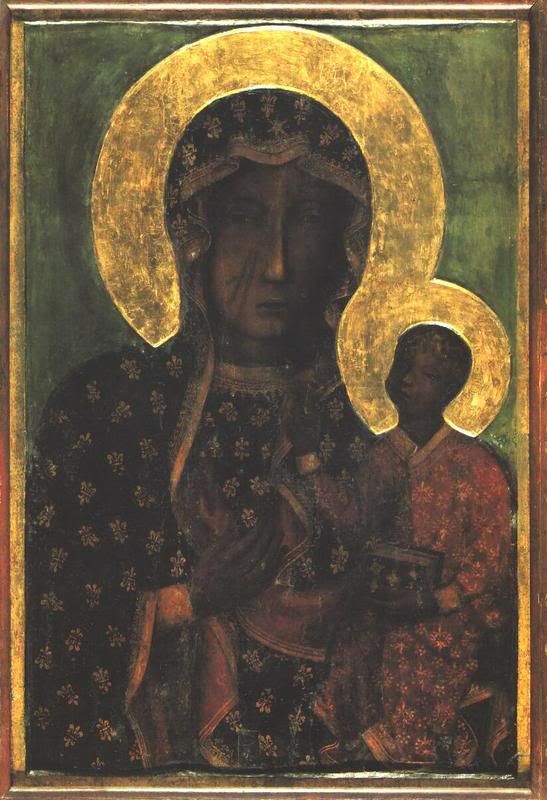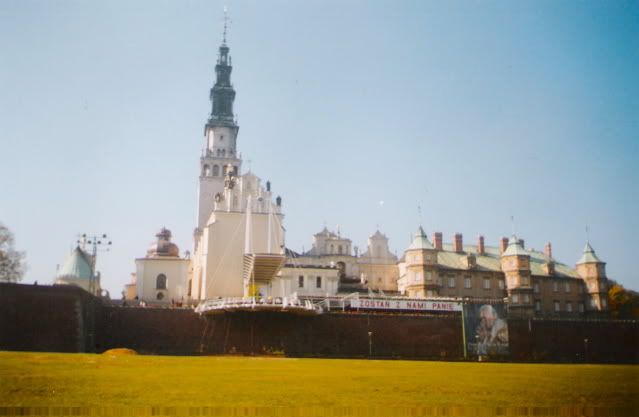Who is the “Black Madonna of Czestochowa”? What is her place in the hearts of the Polish people and of the Polish nation? What part did she play in defending the faith and culture of Poland in the second half of the 20th century? These are but a few of the points we will be exploring in the early part of this series of articles.
Our Lady of Czestochowa, 'The Black Madonna'
In the final set of installments, we will look at the attempted destruction of Polish Catholicism and culture by Soviet Communism in the 20th century. We will then compare what the Soviets attempted to accomplish in Poland with the present attempt of atheistic secularism to erase the memory of Catholic faith and culture on Long Island.
Our Lady of Czestochowa is most aptly described as the Mother of the Polish Nation. It is she who is sent by God to protect her Polish sons and daughters from every “confrontation” that “…lies within the plans of Divine Providence” (Karol Cardinal Wojyla, Farewell address 1976 Eucharistic Congress in Philadelphia)
In the final set of installments, we will look at the attempted destruction of Polish Catholicism and culture by Soviet Communism in the 20th century. We will then compare what the Soviets attempted to accomplish in Poland with the present attempt of atheistic secularism to erase the memory of Catholic faith and culture on Long Island.
Our Lady of Czestochowa is most aptly described as the Mother of the Polish Nation. It is she who is sent by God to protect her Polish sons and daughters from every “confrontation” that “…lies within the plans of Divine Providence” (Karol Cardinal Wojyla, Farewell address 1976 Eucharistic Congress in Philadelphia)
She is the “Woman” promised in Genesis 3:15 who comes to comfort, love and guide her children, as “…in God's Plan”, they confront every trial which the Church “…must take up, and face courageously.”(ibid)
The Black Madonna of Czestochowa icon was, according to legend, painted by St. Luke on a cypress table top taken from the house of the Holy Family. In this beautiful icon, the Blessed Virgin Mary manifests both her humility and shows us our path by pointing with her right hand
to Jesus, the source of our salvation.
Jasna Gora Monastery
In the 17th century, she saved the Jasnan Gora monastery from The Deluge, changing the course of the war in the fight against the Sweedish invasion. In thanksgiving for this great favour from Heaven, King Jan Kazimierz crowned the Black Madonna as Queen and Protector of Poland in the Cathedral of Lwow on April 1, 1656. From that moment on, she became the “Mother of the Polish Nation” serving as the icon of unity for all her Polish children.
In the 17th century, she saved the Jasnan Gora monastery from The Deluge, changing the course of the war in the fight against the Sweedish invasion. In thanksgiving for this great favour from Heaven, King Jan Kazimierz crowned the Black Madonna as Queen and Protector of Poland in the Cathedral of Lwow on April 1, 1656. From that moment on, she became the “Mother of the Polish Nation” serving as the icon of unity for all her Polish children.
Her maternal bond with the people of Poland reaches perhaps it’s zenith in the 20th century, beginning with the “Miracle on the Vistula”, otherwise known as “The Battle of Warsaw”, fought in August of 1920.
This is the story of the decisive confrontation against the Red Army for control of Warsaw. Most observers had given Poland up for dead against the Soviets. Interestingly enough, all of the diplomatic corps had left in anticipation of the impending defeat with one exception, Msgr. Achille Ratti, the Pope’s representative, and future Pius XI.
Another man not willing to concede Catholic Poland to the atheistic forces of Soviet communism was Marshall Jozef Pilsudski, a brave soul who dominated the life of the Second Polish Republic from its inception in 1918 until his death in 1935.
As George Weigel tells us in his seminal work, Witness To Hope, “In a daring move, Pilsudski’s intelligence operatives had detected a gap between the two corps of Trotsky’s army…On August 16, the Poles attacked, and by the night of the 17th, the Red Army, which had begun its own attack on Warsaw on the 14th, had been reduced to a rabble of fleeing refugees at a cost of fewer than 200 Polish casualities” (p.17)
Pilsudski had inflicted a “gigantic, unheard-of defeat”(p.18) on the cause of world revolution, and although Lenin opined that “we will keep shifting from a defensive to an offensive strategy over and over again until we finish them off for good”, for the moment, the expansion of Communism had been stopped. (ibid)
Because of the indomitable faith of one man, and the trust of a nation in the Mother of God, the program of Soviet atheism for Poland was put on hold.This courage and bravery would allow a young boy who had been born a few months earlier to grow up in a free Poland. This boy would be totally consecrated to the Mother of the Polish Nation, and would himself one day in union with her, reverse the expansion of the Soviets in both Poland, and much of the world. His name was Karol Jozef Wojtyla.
Karol and his mother




1 comment:
Great article.
Did you come accross the story of the Swedes' invasion of Poland, which was turned back by the miraculous image of Our Lady brought into battle in an oxcart? I believe I read it in Michener's "Poland".
I look forward to reading more of this inspiring history of the Black Madonnna's maternal care for her beloved Poland.
Post a Comment